 |
|
Here and There introduces art, artists, galleries and museums around Japan that non-Japanese readers and first-time visitors may find of particular interest. The writer claims no art expertise, just a subjective viewpoint acquired over many years' residence in Japan.
|
|
 |
|
|
 |
 |
Metavoids: The Ceramic Art of Yo Akiyama at Musée Tomo
Alan Gleason |
 |
|
One of two galleries displaying the works of Yo Akiyama at Musée Tomo. In the center is Zone II (1991), carbon-impregnated earthenware, steel, 97 x 158 x 102 cm (collection of 21st Century Museum of Contemporary Art, Kanazawa). In the left foreground is Metavoid 24 (2013), stoneware, 44 x 92 x 88 cm. Photo by Alan Gleason |
Yo Akiyama has literally turned the world of ceramic art inside out. His latest works, on view at Musée Tomo until July 24, bring to mind cataclysmic inversions of the Earth's crust. Deep fissures penetrate unwieldy masses of clay whose ravaged surfaces sink inward toward the core as magma erupts from below. If these were tectonic plates, we'd be talking about the end of the world as we know it.
To hear him tell it, Akiyama (b. 1953) was a maverick ceramist from the outset, a rebel who intentionally threw his pots upside down on the wheel at art school. As the exhibition Towards the Sea of Arche reveals, his career has progressed through a number of quantum leaps from one methodology to the next. Inspired by the great postwar ceramist Kazuo Yagi, who was one of his teachers at Kyoto City University of Arts, Akiyama initially devoted himself to kokuto -- carbon-impregnated earthenware fired at low temperatures, with a surface blackened by soot and sometimes polished to an ebony sheen. In the early nineties, however, he began firing his work at high temperatures, a change that both grew from and intensified a fascination that continues to this day with interior/exterior inversions -- and above all, cracks.
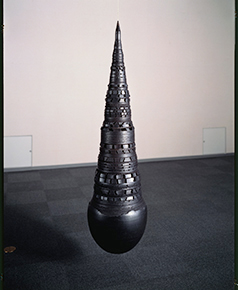 |
|
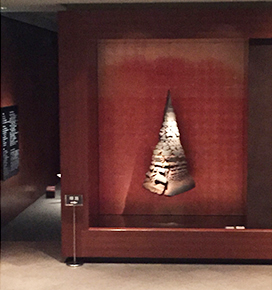 |
|
Pho II (1990), carbon-impregnated earthenware, steel, 181 x 47 x 47 cm; collection of Aichi Prefectural Museum of Art. Photo by Norihiro Ueno |
|
Pho III (1997), stoneware, steel, 159 x 78 x 49 cm, displayed at the entrance to the Akiyama exhibition. Photo by Alan Gleason |
Akiyama also began adopting the vocabulary of geology to describe his work around this time. His Peneplain series from the late eighties was a harbinger of things to come: still working with kokuto, he used a blowtorch to sear the clay and produce fissures just deep enough to create gently undulating surface patterns without disrupting the form itself (a peneplain is a land formation that has been worn nearly flat by erosion). Works like Pho II (1990) and Zone II (1991), in which he restrains the cracking in the service of what chief curator Mari Hanazato calls "controlled forms," are extensions of this style.
|
Geological Age 16 (2000), stoneware, 53 x 81 x 58 cm. Photo by Kazuo Fukunaga |
Hanazato's overview of Akiyama's oeuvre, translated into English in the exhibition catalogue, provides an invaluable guide to the evolution of his work. She sees 1993 as a watershed year, when Akiyama shifted over to high-temperature firing and launched his long running Geological Age series. As the name implies, the results resemble something primordial (a word the artist favors), forged by planetary forces of such immense scale that human civilization is a mere hiccup by comparison. The cracks run so deep that the clay beneath bursts from its confines, splitting the surface into puny fragments that cannot hold. The contrast between Pho III (1997) and its predecessors illustrates this transformation: though it retains contours similar to Pho II, the severity of the cracking and its disruption of the surface threaten to strip the work of all refinement. Geological Age 16 (2000) is the apotheosis of this approach -- a massive, shapeless chunk of rock that looks like a remnant from an exploded asteroid or a volcano that collapsed in on itself.
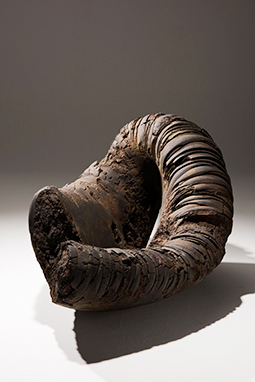 |
|
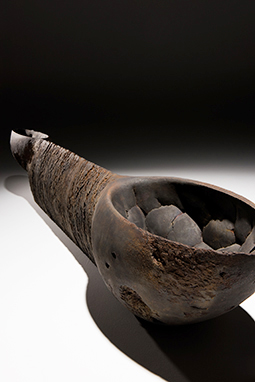 |
|
Left: Metavoid 30 (2015), stoneware, 60 x 113 x 66 cm. Right: Metavoid 31 (2015), stoneware, 34 x 198 x 36 cm. Photos by Kazuo Fukunaga |
In the 2000s Akiyama began to reassert a bit of order over all this primeval chaos. His Metavoid series plays with the notion of the "vessel," in which exterior and interior are topologically one and the same. Some of these works contain hollows that give them a passing resemblance to the pots and bowls of traditional ceramics, while others are annular, the ring or torus being another form whose inside and outside are interchangeable. Though nearly as rough-hewn and primitive as the Geological Age pieces, their rounded contours feel more organic, evoking ancient ammonites unearthed from Devonian sludge. In a more or less concurrent series, Heterophony, Akiyama stacks bowls turned on a potter's wheel and fires them in erratic, lopsided configurations that he likens to music in which the same melody is played by multiple voices staggered over time.
|
Heterophony 4 (2009), stoneware, 102 x 99 x 96 cm. Photo by Seiji Toyonaga |
It goes without saying that this is a powerful, sometimes overwhelming, body of work. The museum has done well to limit itself to displaying some 40 of Akiyama's creations in all, evenly divided between recent and older pieces. Even so, the close proximity of so many monumental objects in the two relatively modest galleries can feel a bit claustrophobic. The layout, however, does ample justice to the works on display. In one room a serpentine dais wriggles across the floor, with sculptures lying atop it at suitable intervals like giant fossils on a seabed. In both galleries the lighting is subdued, but the individual works are dramatically spotlit. The effect is something like wandering through a surrealist's rock garden by moonlight.
 |
|
 |
|
The front entrance of Musée Tomo in Toranomon, Tokyo. The Nishikubo Building was designed by Sakakura Associates and completed in 2003. Photo provided by Musée Tomo |
|
Portrait of a Lady (1988), a mural by Toko Shinoda, greets visitors at the far end of the long entryway to Musée Tomo. Photo by Alan Gleason |
In the few years since it opened in 2003, Musée Tomo has established itself as a premier destination for fans of contemporary Japanese ceramics. (Artscape has covered its must-see Kikuchi Biennale twice: see here and here.) Founder Tomo Kikuchi built the museum to house her own collection, and the keenness of her eye is evident not only in the exhibits but in the design of the venue as well. It occupies the basement of the Nishikubo Building, a handsome limestone-faced edifice perched on a hill in central Tokyo. As one enters down a long corridor, the eye is drawn to the abstract sumi-ink painting by Toko Shinoda at the end. To the right, a French restaurant on the premises faces a century-old garden, part of the estate once owned by Tomo's father, the industrialist Kanjitsu Kikuchi. To the left is a grand spiral staircase, its silver-washi walls inscribed with calligraphy by Shinoda, that leads down to the galleries. It is a disarmingly tranquil overture to the symphonic blast of cosmic forces that awaits below at the Akiyama exhibition.
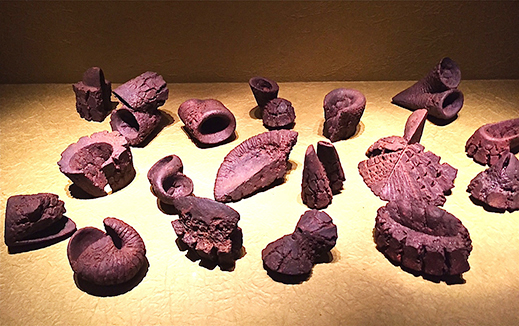 |
|
Models (2004-14), stoneware. A display of maquettes prepared by Akiyama for his larger works provides a coda to the exhibition. Photo by Alan Gleason
All photos by permission of Musée Tomo.
|
 |
|
| |
Nishikubo Bldg., 4-1-35 Toranomon, Minato-ku, Tokyo
Phone: 03-5733-5131
Hours: 11 a.m. to 6 p.m. (last entry 30 minutes before closing)
Closed Mondays (except 18 July 2016) and 19 July 2016
Access: 6 minutes' walk from exit 4b, Kamiyacho Station on the Metro Hibiya Line; 8 minutes' walk from Roppongi-Itchome Station or exit 13, Tameike-Sanno Station on the Metro Namboku Line; 10 minutes' walk from exit 3, Toranomon Station on the Metro Ginza Line |
|
|
| |
 |
Alan Gleason
Alan Gleason is a translator, editor and writer based in Tokyo, where he has lived for 30 years. In addition to writing about the Japanese art scene he has edited and translated works on Japanese theater (from kabuki to the avant-garde) and music (both traditional and contemporary). |
|
|
|
|
|
|
|
|
|
 |
|